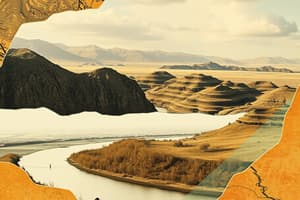Podcast
Questions and Answers
What does the Domino Theory imply?
What does the Domino Theory imply?
- If one nation comes under Communist control, neighboring nations will also come under Communist control. (correct)
- If one nation has a strong economy, neighboring nations will thrive.
- If one nation embraces democracy, neighboring nations will also do the same.
- If one nation falls into poverty, neighboring nations will follow.
What are diasporas?
What are diasporas?
Groups of people who have left their home country to live and work abroad.
What is Brain Drain?
What is Brain Drain?
When the smartest people of a nation emigrate to more developed countries.
What is the Belt and Road Initiative (BRI)?
What is the Belt and Road Initiative (BRI)?
What does the Poverty Environment Initiative seek to address?
What does the Poverty Environment Initiative seek to address?
What is ASEAN?
What is ASEAN?
Who were the Khmer Rouge?
Who were the Khmer Rouge?
What is Timor-Leste known for?
What is Timor-Leste known for?
What is Southeast Asia's major food crop?
What is Southeast Asia's major food crop?
What is significant about Indonesia?
What is significant about Indonesia?
What is unique about Laos?
What is unique about Laos?
What notable geographic feature does Myanmar contain?
What notable geographic feature does Myanmar contain?
What characterizes Singapore's business environment?
What characterizes Singapore's business environment?
How is the Philippines geographically composed?
How is the Philippines geographically composed?
What makes Thailand unique in Southeast Asia?
What makes Thailand unique in Southeast Asia?
How is Vietnam divided geographically?
How is Vietnam divided geographically?
What type of government does Brunei have?
What type of government does Brunei have?
Match the following concepts of Southeast Asian culture:
Match the following concepts of Southeast Asian culture:
What is Buddhism?
What is Buddhism?
What does Nirvana represent in Buddhism?
What does Nirvana represent in Buddhism?
Flashcards are hidden until you start studying
Study Notes
Key Theories and Concepts
- Domino Theory: Contention that if one nation falls under Communist influence, surrounding nations may follow suit, impacting global geopolitics.
- Diasporas: Communities formed by individuals leaving their home countries for new opportunities abroad, often leading to cultural exchange and economic impacts in both origin and host countries.
- Brain Drain: The emigration of highly educated and skilled individuals from a nation to more developed areas, resulting in a loss of talent and expertise.
Initiatives and Organizations
- Belt and Road Initiative (BRI): China's strategic plan to enhance global trade by constructing infrastructure such as roads, ports, and airports.
- Poverty Environment Initiative: A program targeting environmental issues and the socio-economic factors causing them in Southeast Asia.
- ASEAN (Association of Southeast Asian Nations): Established in 1967 to foster economic growth and political stability among Southeast Asian nations.
Historical and Cultural Context
- Khmer Rouge: Communist regime that took control of Cambodia in 1975, known for its devastating impact on society and culture.
- Timor-Leste: Gained independence from Indonesia in 2002, marking a significant shift in Southeast Asian geopolitical landscapes.
- Indonesia: Known as the East Indies during Dutch colonization; it is the largest nation in Southeast Asia and a major example of colonial impact on regional development.
Geography and Demographics
- Southeast Asia's Major Food Crop: Rice, a staple food and critical component of the region's agriculture and economy.
- Laos: The only landlocked country in Southeast Asia, presenting distinct economic challenges.
- Myanmar (Burma): Home to the Irrawaddy River, a vital waterway for trade and agriculture.
Countries Overview
- Singapore: Notable for its stringent laws and economic prosperity, making it a competitive global business hub.
- Philippines: An archipelago of over 7,000 islands, highlighting the challenges of governance and infrastructure across diverse locales.
- Thailand: Unique for avoiding colonial rule, contributing to its cultural continuity and independence.
Cultural Characteristics
- Four Major Traits of Southeast Asian Culture:
- Showing respect
- Avoiding shame
- Treasuring family values
- Maintaining an easy-going attitude toward life
Spirituality and Beliefs
- Buddhism: Philosophical and spiritual teaching emphasizing the cessation of suffering through the relinquishment of desire, guiding moral conduct and meditation practices.
- Nirvana: The ultimate goal in Buddhism representing the end of suffering and a state of liberation from the cycle of rebirth.
Studying That Suits You
Use AI to generate personalized quizzes and flashcards to suit your learning preferences.




